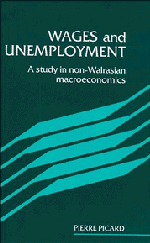Book contents
- Frontmatter
- Contents
- Acknowledgements
- Introduction
- 1 Price rigidities and temporary equilibrium
- 2 Wage rigidity and short-run macroeconomic equilibrium
- 3 Real wages and the inflation—unemployment dilemma
- 4 External constraint, oil shock and economic policy
- 5 Implicit contracts and unions
- 6 Introduction to efficiency wage models
- 7 Efficiency wages, employment fluctuations and fiscal policy
- 8 Labour market dualism, efficiency wages and optimal taxation
- Notes
- References
- Author index
- Subject index
8 - Labour market dualism, efficiency wages and optimal taxation
Published online by Cambridge University Press: 28 October 2009
- Frontmatter
- Contents
- Acknowledgements
- Introduction
- 1 Price rigidities and temporary equilibrium
- 2 Wage rigidity and short-run macroeconomic equilibrium
- 3 Real wages and the inflation—unemployment dilemma
- 4 External constraint, oil shock and economic policy
- 5 Implicit contracts and unions
- 6 Introduction to efficiency wage models
- 7 Efficiency wages, employment fluctuations and fiscal policy
- 8 Labour market dualism, efficiency wages and optimal taxation
- Notes
- References
- Author index
- Subject index
Summary
This chapter aims at analysing the optimal taxation policy, in an economy where inefficient underemployment results from real wage rigidity. Labour subsidizing is then a helpful policy instrument, since it allows the reduction of inefficiency due to production costs being too high, by disconnecting consumption and production wages. Unfortunately, the redistributive effects of such a policy usually involve additional distortions that may prevent the first-best optimum being reached. Consider for instance the Shapiro—Stiglitz efficiency wage model. The no-shirking constraint itself entails that there exists a difference between the (net of effort) incomes of employed and unemployed individuals and this may conceivably be considered as inefficient by an egalitarian social planner. Assume that no pure profit can be taxed away. Subsidizing employment and reducing simultaneously the unemployment benefit to balance the government budget constraint would allow the reaching of the perfect information employment level, but this policy obviously involves redistributive consequences. Individuals who get a job because of this tax policy are certainly better off, but unemployed workers are in a worse situation. It is this relation between equity and efficiency in labour taxation policy that we wish to examine in this chapter.
The real wage rigidity will be formalized by drawing from the theories of labour market dualism.
- Type
- Chapter
- Information
- Wages and UnemploymentA Study in Non-Walrasian Macroeconomics, pp. 229 - 246Publisher: Cambridge University PressPrint publication year: 1993



